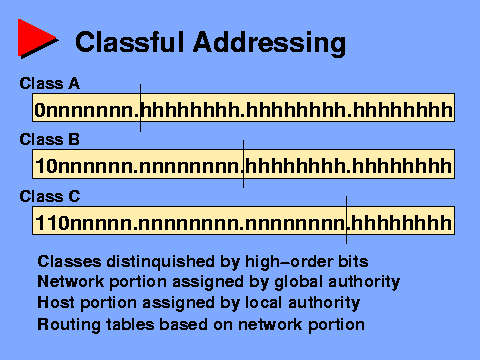

There were three address classes to chose from: A, B, or C, corresponding to 8-bit, 16-bit, or 24-bit prefixes. No other prefix lengths were allowed, and there was no concept of nesting a group of 24-bit prefixes, for example, within a 16-bit prefix.
An address was slotted into one of three address classes based on its high-order bits. Addresses beginning with 0 were considered class A; addresses beginning 10 were class B; addresses beginning 110 class C. Two other classes were also defined, class D addresses beginning 1110 and class E addresses beginning 1111, though neither of these two address classes were normally used. For humans, the easiest way to distinguish between different address classes is to use the first decimal number in the IP address:
| First octet | Address Class |
|---|---|
| 0-127 | Class A |
| 128-191 | Class B |
| 192-223 | Class C |
| 224-239 | Class D |
| 240-255 | Class E |
For example, 128.8.74.1 is a Class B address because the first octet, 128, lies in the 128-191 range. Likewise, 10.10.191.1 is a Class A address (because the first octet is 10) and 208.130.29.33 is a Class C (because the first octet is 208). If this seems at all confusing, convert these addresses into binary and verify for yourselves that the initial bits correspond to the pattern shown in the diagram.
Upon installing a new Internet connection, the network engineer would request a Class A, B, or C network, depending on the expected size of the installed network. For example, the U.S. Department of Defense, a very large network, was assigned a Class A; the University of Maryland, a typical mid-sized network, was assigned a Class B network; and a small consulting firm I once worked for was assigned a Class C network.
The Internet Assigned Numbers Authority (IANA) oversaw all classful network assignments. Only the network bits were assigned by IANA. For example, a request for a Class C network might have been met by assigning 192.17.34.0. As a Class C, the first three bytes were fixed by IANA, and the last byte was assigned by the local network administrator. No attempt was made to assign the addresses in a hierarchical fashion. The first Class B assigned was 128.1.0.0, the next was 128.2.0.0, and so on.
Routers processed packets according to their classful network. For example, consider a packet addressed to 130.17.44.2. First, the address is determined to be a Class B (its two high bits are 10), then split to determine its membership in the 130.17.0.0 classful network. The routing table would have an entry for each classful network, in this case 130.17.0.0, which would determine how the packet should be delivered.